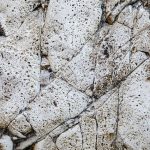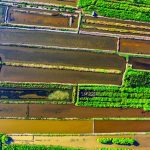You should use woven geotextiles when your project needs reinforcement, long-term stability, and high load-bearing capacity—they’re strong and resist deformation. Choose nonwoven geotextiles for drainage, filtration, cushioning, and flexible soil separation, especially on uneven terrain. Soil conditions and stress levels heavily influence which works best. Balancing cost, durability, and installation ease matters too. If you want to make the right geotextile choice, understanding these factors will help guarantee your project’s success.
Table of Contents
Key Takeaways
- Use woven geotextiles for reinforcement, heavy load support, and long-term structural stability in roads and retaining walls.
- Choose nonwoven geotextiles for superior filtration, drainage, and cushioning in drainage layers and soil separation.
- Select woven geotextiles when low elongation and dimensional stability are critical to prevent deformation under pressure.
- Opt for nonwoven geotextiles on uneven surfaces requiring flexibility and easy installation with excellent puncture resistance.
- Consider project lifespan and environmental impact; woven geotextiles offer longevity and lower maintenance versus faster degradation of nonwovens.
Understanding the Basic Differences Between Woven and Nonwoven Geotextiles
When you look at geotextiles, you’ll find two main types: woven and nonwoven.
You’ll notice woven geotextiles are made by interlacing yarns in a crisscross pattern, giving them strength and durability. On the other hand, nonwoven geotextiles are created by bonding fibers together, either mechanically or chemically, resulting in a fabric that’s more flexible and porous.
You’ll find woven types excel at reinforcement and separation in construction, while nonwovens are better at filtration and drainage.
Choosing between them depends on what your project demands—whether you need toughness and structural support or permeability and cushioning.
Understanding these fundamental differences helps you pick the right geotextile to guarantee your project’s success without overcomplicating your decision.
Key Properties of Woven Geotextiles
Woven geotextiles stand out for their impressive strength and durability, traits that come from their unique woven construction.
Woven geotextiles offer remarkable strength and durability thanks to their distinct woven design.
When you choose woven geotextiles, you get high tensile strength, which makes them perfect for reinforcement applications like roadways and retaining walls. They also offer excellent dimensional stability, so they won’t stretch or deform under pressure, maintaining your project’s integrity.
Their low elongation means they respond predictably under load, giving you reliable performance. Additionally, woven geotextiles provide good filtration and drainage capabilities, though they’re not as efficient as nonwoven types in this regard.
If you need a material that combines strength with moderate permeability, woven geotextiles serve you well. Their ability to withstand harsh environmental conditions guarantees long-lasting effectiveness in your project.
Key Properties of Nonwoven Geotextiles
Nonwoven geotextiles offer exceptional filtration and drainage thanks to their random fiber arrangement, which creates a porous yet strong fabric.
When you use them, you benefit from high permeability, allowing water to pass through while retaining soil particles. They also provide excellent puncture resistance and cushioning, making them ideal for protecting underlying layers.
Their flexibility lets you conform to uneven surfaces easily, and their lightweight nature simplifies installation. Additionally, nonwoven geotextiles resist chemical and biological degradation, ensuring long-term durability in harsh environments.
You’ll find their ability to separate soil layers prevents mixing, maintaining structural integrity.
Applications Where Woven Geotextiles Excel
Although both types of geotextiles serve important roles, you’ll find woven geotextiles excel in applications requiring high strength and dimensional stability.
When you need to reinforce soil in roadways, retaining walls, or embankments, woven geotextiles provide the durability and tensile strength necessary to support heavy loads and prevent soil movement. They’re also ideal for separation tasks where you want to keep different soil layers from mixing, especially under pavement or railroad tracks.
Because woven geotextiles resist stretching and maintain shape under pressure, they’re your best bet for erosion control on steep slopes or channel linings.
If your project demands long-term performance under mechanical stress, woven geotextiles will give you reliable reinforcement and stability you can count on.
Applications Where Nonwoven Geotextiles Are Preferred
You’ll find nonwoven geotextiles work best when you need effective drainage and filtration, allowing water to pass while keeping soil in place.
They’re also great for soil separation and protecting delicate surfaces from damage.
Let’s explore why these qualities make nonwoven fabrics the preferred choice in such applications.
Drainage and Filtration
Effective drainage and filtration are essential in many construction and landscaping projects, and you’ll find that nonwoven geotextiles excel in these roles.
When water needs to flow freely without soil clogging the system, nonwoven fabrics act like a fine filter, allowing water to pass while trapping soil particles. This makes them perfect for drainage layers in retaining walls, French drains, and roadways.
You’ll also appreciate their high permeability and ability to maintain flow rates under pressure. Unlike woven geotextiles, nonwovens resist clogging better, ensuring long-term performance.
Soil Separation and Protection
When you need to keep different soil layers from mixing while protecting the ground beneath, nonwoven geotextiles offer an ideal solution.
Their dense, felt-like structure acts as an effective barrier, preventing fine soil particles from migrating into coarser base materials. This separation maintains soil stability and prolongs the lifespan of your project.
You’ll often find nonwoven geotextiles used in road construction, embankments, and erosion control where soil mixing could compromise structural integrity. Additionally, their cushioning properties shield underlying surfaces from damage caused by heavy equipment or shifting loads.
How Soil Conditions Influence Geotextile Choice
You’ll want to take into account soil permeability when choosing between woven and nonwoven geotextiles, as it affects water flow and drainage.
If erosion control and stability are priorities, the fabric’s strength and filtration capabilities become essential.
Understanding these soil conditions helps you pick the right geotextile to keep your project secure and efficient.
Soil Permeability Effects
Although soil permeability varies widely, understanding its impact is crucial for choosing the right geotextile.
If you’re working with highly permeable soils like sand or gravel, you’ll want a geotextile that allows water to pass through easily, preventing water buildup and maintaining soil stability. Nonwoven geotextiles often work well here because their open structure promotes excellent drainage.
On the other hand, if your soil has low permeability, such as clay, you need a geotextile that balances filtration without clogging. Woven geotextiles are typically better suited for these conditions because they provide strength and controlled permeability.
Erosion and Stability
Since soil conditions directly impact erosion and stability, choosing the right geotextile becomes essential to protect your project. You’ll want woven geotextiles for high-stress areas needing reinforcement, while nonwoven types suit erosion control where filtration is key. Understanding your soil’s texture and drainage helps you decide which fabric provides durability without compromising permeability.
| Soil Condition | Recommended Geotextile |
|---|---|
| Coarse, well-drained | Woven (high strength) |
| Fine, poorly drained | Nonwoven (better filtration) |
| Mixed or variable | Combination or site-specific choice |
Considering Load and Stress Requirements in Geotextile Selection
When selecting a geotextile, understanding the load and stress it must withstand is essential to guarantee long-term performance.
You’ll want to assess the type and magnitude of forces involved—whether it’s heavy traffic loads, soil pressure, or dynamic stresses from shifting ground.
Woven geotextiles excel under high tensile loads due to their strength and durability, making them ideal for reinforcement and stabilization projects.
On the other hand, nonwoven geotextiles offer superior elongation and drainage capabilities but generally handle lower tensile stresses.
By matching your geotextile choice to the specific load conditions, you confirm your project’s structural integrity and avoid premature failure.
Aligning geotextile selection with load demands ensures lasting structural integrity and prevents early failure.
Keep in mind the expected stress patterns throughout the project’s lifespan to select the most appropriate material effectively.
Cost Factors and Longevity of Woven vs. Nonwoven Geotextiles
Understanding how woven and nonwoven geotextiles perform under different loads helps you make informed decisions about their cost and lifespan.
Woven geotextiles generally cost more upfront due to their strength and durability, making them ideal for long-term projects where reinforcement is critical. They resist wear and maintain integrity over time, saving you replacement costs.
Nonwoven geotextiles, meanwhile, are typically less expensive and excel in filtration and drainage but may degrade faster under heavy stress or UV exposure. If your project demands short-term use or focuses on filtration, nonwovens offer cost-effective performance.
However, for applications requiring longevity and load-bearing capacity, investing in woven geotextiles pays off through extended service life and reduced maintenance needs.
Weigh these factors carefully to match your budget and project goals.
Environmental and Installation Considerations for Geotextile Use
Although choosing the right geotextile depends heavily on cost and performance, you also need to take into account environmental impact and installation challenges.
Woven geotextiles tend to have a lower carbon footprint due to their durability, meaning you won’t need frequent replacements. Nonwoven fabrics, however, often degrade faster, potentially increasing waste.
When installing, woven geotextiles require careful handling to avoid damage since their structure is less forgiving. Nonwovens are more flexible and easier to conform to uneven surfaces, speeding up installation.
You should also consider site conditions—nonwovens excel in filtration and drainage, while wovens provide stronger separation and reinforcement.
Balancing these factors guarantees you choose a geotextile that meets your project’s sustainability goals without complicating the installation process.
Frequently Asked Questions
Can Geotextiles Be Recycled After Project Completion?
You might wonder if geotextiles can be recycled after use. The truth is, recycling options exist but depend on the material type and local facilities. Don’t give up—check with your recycler for possibilities.
How Do Geotextiles Affect Local Groundwater Flow?
You’ll find geotextiles influence local groundwater flow by allowing water to pass while filtering soil particles, preventing clogging. They help maintain natural flow patterns but can alter flow rates depending on material permeability and installation.
Are There Any Health Risks Associated With Handling Geotextiles?
Oh sure, geotextiles might secretly plot to invade your bloodstream—just kidding! You’ll be fine handling them normally, but wearing gloves and masks helps avoid irritation or inhaling fibers. Safety first, not paranoia!
What Are the Environmental Impacts of Geotextile Manufacturing?
You’ll find that geotextile manufacturing consumes energy and emits greenhouse gases. Plus, it often uses non-renewable resources. Choosing recycled materials or eco-friendly options can help reduce these environmental impacts on your projects.
How Do UV Exposure and Weathering Affect Geotextile Performance?
UV exposure and weathering act like relentless sun and rain, breaking down your geotextile’s fibers over time. You’ll notice weakened strength and reduced durability, so protecting it guarantees your project stands strong against nature’s wear and tear.
- Recycling Nonwoven Fabrics: Is It Possible? - July 11, 2025
- Recycling Nonwoven Fabrics: Is It Possible? - July 11, 2025
- Recycling Nonwoven Fabrics: Is It Possible? - July 11, 2025







